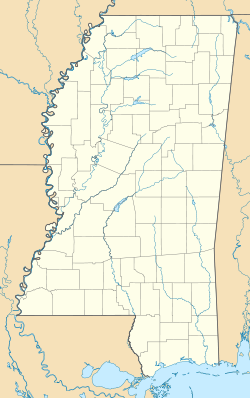Development
Chartered on May 13, 1802, by the General Assembly of the Mississippi Territory, the territorial legislature from 1798, prior to statehood in 1817, [6] Jefferson College was the first institution of higher learning in the territory. [7] It opened in 1811 with 15 students, as a preparatory school, under the name of the Washington Academy, in a one-room, wood-framed structure. [6] By 1817, the institution had become a fully developed college. [8] The first permanent buildings, constructed of brick, were completed in 1820. [6] White Turpin served as a trustee.
In 1826, the Governor and Lieutenant Governor of Mississippi were placed on the college's Board of Trustees, and the state legislature was authorized to fill vacancies on the board. Three years later, the college decided to reorganize on the model of the U.S. Military Academy at West Point. E. B. Wiliston became the college's president, and military training was placed under Maj. John Holbrook, who had written a book on military tactics. One year later, the school's enrollment had increased from 98 to 150 cadets. [9]
Maj. Holbrook died in 1832, and was replaced by Alden Partridge, a Northerner noted for his theories on proper military education, and for founding numerous military academies, most of which failed. Partridge's views on slavery were not popular in the state, which led to a decline in support for the school, and Partridge resigned. The school's board decided to drop the West Point system of education; almost immediately, the college's enrollment declined. [9]
By 1840, Jefferson College offered the degrees of Bachelor of Arts and Master of Arts. [10] In 1841 there was a major building fire at the school. [11]
In 1850, the college reverted to providing a military education, which again led to a resurgence of growth. [9]
Postbellum
During the American Civil War (1861–1865), Jefferson College was closed. When the war ended, the buildings were used during the Reconstruction era (1865–1877) by the Freedmen's Bureau newly set up within the United States Department of War in the US government to aid in the transition of the former slaves to a society of free labor. In November 1865, the school's Board of Trustees regained control of the facility from the bureau. [6] The institution reopened in 1866 as a preparatory school and continued as such for the next 98 years until it closed in 1964. [8]
Between 1872 and 1911, under the tenure of Superintendent J.S. Raymond, the college had its longest interval of stable governance, with increased enrollment. By 1893, the institution had returned to being a military school, taking the name Jefferson Military College. Instruction was entirely secondary education. [6] Early in the 20th century, dormitories were built to accommodate more recruits. By the late 1930s, enrollment had increased to about 100 students. [12]
Decline
Following World War II, declining student enrollment, low tuition, and lack of external funding caused financial hardship for Jefferson College. After 150 years of operation and unable to pay its debts, the facility closed in May 1964. In 1965, all buildings and lands owned by Jefferson College were conveyed to the State of Mississippi in exchange for discharging the school's debts. [6]
In 1971, Jefferson College was placed under administrative control of the Mississippi Department of Archives and History. Detailed plans were developed for preserving the historic buildings, and restoration work began in the mid-1970s. In 1977, the former campus of Jefferson College was reopened to the public as a State Historic Site. [6]



